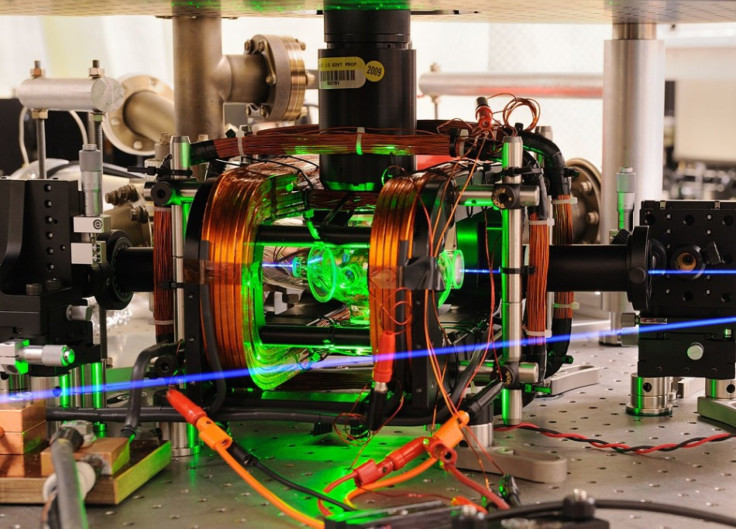Scientists Hint at Smartphone-sized Quantum Computers

Researchers say smartphone-sized quantum computers could be developed with the help of microwaves and ions, hinting at the possibility of smaller quantum computing devices in the future.
Physicists at the National Institute of Standards and Technology (NIST) have for the first time linked the quantum properties of two separated ions by manipulating them with microwaves rather than the usual laser beams.
They suggest it may be possible to replace an exotic room-sized quantum computing "laser park" with miniaturized, commercial microwave technology similar to that used in smart phones.
"It's conceivable a modest-sized quantum computer could eventually look like a smart phone combined with a laser pointer-like device, while sophisticated machines might have an overall footprint comparable to a regular desktop PC," says NIST physicist Dietrich Leibfried.
Scientists say microwave components could be expanded and upgraded more easily to build practical systems of thousands of ions for quantum computing and simulations, compared to complex, expensive laser sources.
Though microwaves, the carrier of wireless communications, have been used earlier to manipulate single ions, NIST researchers are the first to position microwaves sources close enough to the ions-just 30 micrometers away-and create the conditions enabling entanglement.
Entanglement is a quantum phenomenon expected to be crucial for transporting information and correcting errors in quantum computers.
Scientists integrated wiring for microwave sources directly on a chip-sized ion trap and used a desktop-scale table of lasers, mirrors and lenses that is only about one-tenth of the size previously required. Though low-power ultraviolet lasers are still needed to cool the ions and observe experimental results, it might eventually be made as small as those in portable DVD players.
"Although quantum computers are not thought of as convenience devices that everybody wants to carry around, they could use microwave electronics similar to what is used in smart phones. These components are well developed for a mass market to support innovation and reduce costs. The prospect excites us," Leibfried added.
Ions are a leading candidate for use as quantum bits, or qubits, to hold information in a quantum computer. Although other promising candidates for qubits-notably superconducting circuits, or "artificial atoms"-are manipulated on chips with microwaves, ion qubits are at a more advanced stage experimentally in that more ions can be controlled with better accuracy and less loss of information.
In the latest experiments, the NIST team used microwaves to rotate the "spins" of individual magnesium ions and entangle the spins of a pair of ions. This is a "universal" set of quantum logic operations because rotations and entanglement can be combined in sequence to perform any calculation allowed by quantum mechanics, Leibfried says.
In the experiments, the two ions were held by electromagnetic fields, hovering above an ion trap chip consisting of gold electrodes electroplated onto an aluminum nitride backing. Some of the electrodes were activated to create pulses of oscillating microwave radiation around the ions. Radiation frequencies are in the 1 to 2 gigahertz range.
The microwaves produce magnetic fields used to rotate the ions' spins, which can be thought of as tiny bar magnets pointing in different directions. The orientation of these tiny bar magnets is one of the quantum properties used to represent information.
Scientists entangled the ions by adapting a technique they first developed with lasers. If the microwaves' magnetic fields gradually increase across the ions in just the right way, the ions' motion can be excited depending on the spin orientations, and the spins can become entangled in the process.
Scientists had to find the right combination of settings in the three electrodes that provided the optimal change in the oscillating magnetic fields across the extent of the ions' motion while minimizing other, unwanted effects. The properties of the entangled ions are linked, such that a measurement of one ion would reveal the state of the other.
A quantum computer is a device for computation making direct use of quantum mechanical phenomena, such as superposition and entanglement, to perform operations on data. The basic principle behind quantum computation is that quantum properties can be used to represent data and perform operations on these data.
Quantum computers would harness the unusual rules of quantum physics to solve certain problems-such as breaking today's most widely used data encryption codes, which are currently intractable even with supercomputers.
A nearer-term goal is to design quantum simulations of important scientific problems, to explore quantum mysteries such as high-temperature superconductivity, the disappearance of electrical resistance in certain materials when sufficiently chilled.
Scientists say the use of microwaves reduces errors introduced by instabilities in laser beam pointing and power as well as laser-induced spontaneous emissions by the ions. However, microwave operations need to be improved to enable practical quantum computations or simulations.
There is still a long way to go. The NIST researchers achieved only entanglement 76 percent of the time, compared with the best laser-controlled operations at 99.3 percent.
© Copyright IBTimes 2024. All rights reserved.




















